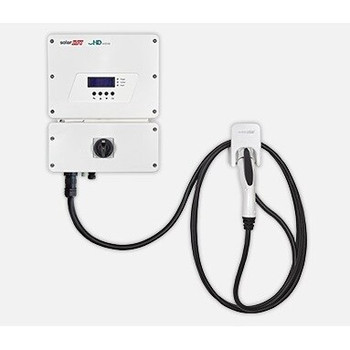EV Charging Stations
-

SolarEdge
$884.99Introducing the SolarEdge Home EV Charger The SolarEdge Home EV Charger automatically uses available solar energy for EV-charging, providing you with the convenience and freedom of charging fast from home with cleaner, cheaper, renewable energy. Easy...$884.99 -

SolarEdge
2020: SOLAREDGE, SE3800H-US000BNW4, SET APP, HD WAVE W EV CHARGER, NON-ISOLATED INVERTER, 3800W, 240 VAC, WITH RGM SolarEdge SetApp HD-Wave Single-Phase Inverters with EV Charger The worlds first inverter that charges an...
The JuiceBox is a brand of electric vehicle (EV) charging stations designed for residential and commercial use. The JuiceBox charging stations provide fast and reliable charging for electric vehicles through their built-in WiFi connectivity, smartphone app control, and customizable settings. They are compatible with most EVs available on the market and support Level 2 charging, which can add up to 25 miles of range per hour of charging. The charging stations are also equipped with safety features such as automatic shut off, ground fault protection, and a weather-resistant design to enable outdoor use.
Frequently Asked Questions About EV Charging Stations
A: There are three types of EV charging options available: Level 1 charging, Level 2 charging, and DC fast charging.
A: Level 1 charging is the slowest type of charging, as it uses a standard 120-volt outlet to charge an electric vehicle. It provides a charging rate of around 4-5 miles of range per hour of charging, which means it can take around 8-10 hours to fully charge a typical electric vehicle.
A: Level 2 charging is faster than Level 1 charging, as it uses a 240-volt outlet to charge an electric vehicle. It provides a charging rate of around 20-25 miles of range per hour of charging, which means it can take around 4-6 hours to fully charge a typical electric vehicle.
A: DC fast charging is the fastest type of charging, as it uses a direct current (DC) to charge an electric vehicle. It provides a charging rate of around 60-80 miles of range per 20-30 minutes of charging, which means it can take around 30-45 minutes to charge an electric vehicle up to 80% of its battery capacity.
A: Level 1 and Level 2 charging options can be found at home, as well as at various public charging stations. DC fast charging options are primarily located at public charging stations along highways and major travel routes.
A: Yes, SolarEdge makes an EV Charging Kit (SE-EV-SA-KIT-LJ40P) that can integrate into some models of their PV inverters. This is a very efficient option, because it takes DC power directly from the inverter to the EV, avoiding the losses of converting from DC to AC and then back to DC.
A: The cost of using these charging options varies depending on the location and the provider. Level 1 charging can be done at home using a standard outlet, which may not incur any additional costs. Level 2 charging may require the installation of a dedicated charging station, which can cost between $500 and $2,000. DC fast charging typically costs more than Level 2 charging, with some providers charging per minute or per kWh of electricity used.
A: Level 1 charging can be done using a standard 120-volt outlet, while Level 2 charging requires a dedicated charging station that is installed by a professional electrician. DC fast charging requires a specialized charging station that is typically only available at public charging stations.
A: Most electric vehicles can be charged using these charging options, but it is important to check the vehicle's manual to ensure compatibility. Some electric vehicles may require specific charging equipment or may not be able to use DC fast charging options.
A: The time it takes to charge an electric vehicle using these charging options depends on the type of charging and the vehicle's battery capacity. Level 1 charging can take up to 10 hours to fully charge an electric vehicle, while Level 2 charging can take up to 6 hours. DC fast charging can charge an electric vehicle up to 80% in around 30-45 minutes.
A: Most electric vehicles have a built-in indicator that shows the battery's charging status. Additionally, some charging stations also have indicators that show the charging status. It is important to check the vehicle's manual and the charging station's instructions to ensure that the battery is fully charged before disconnecting.
